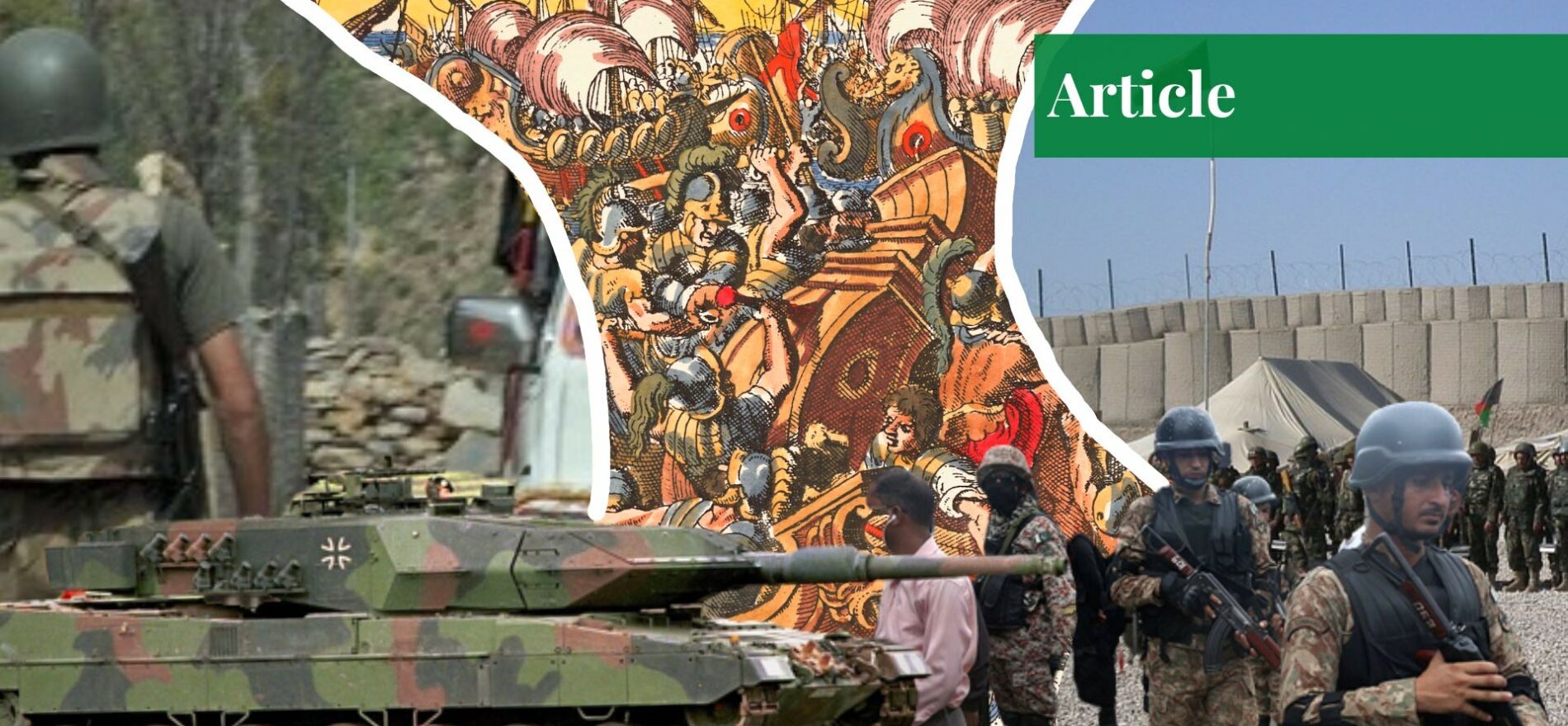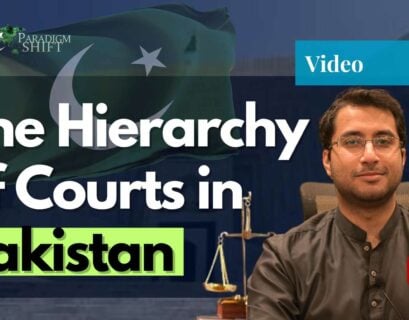Hafsa Ammar is a graduate of the National Defence University, Islamabad. Her areas of expertise are narrative building and propaganda warfare, centered around the Soviet Union and modern-day Russia.
Introduction
Victor’s Peace is essentially defeating the other party by force. It becomes a necessity when peace processes fail and there is a need to stop the violence and ongoing war immediately. Though it has limitations of its own, it is suitable for the resolution of protracted conflicts. In contemporary world politics, conflicts are less likely to be resolved with conventional and traditional efforts like political settlements.
Conflict resolution plays an important role in carrying out the peace process by transforming a conflict into negotiations and mediations. However, some conflicts do require forceful intervention as a last resort when all other possible means to tackle the conflict have failed.
Victor’s Peace Through the Ages
The historical perspective of victor’s peace portrays a realistic account of how peace can best be achieved through military victory, dominated by the victor in the conflict. Essentially, the core argument of victor’s peace denotes military to be the last resort in attaining peace in war-ridden states, but hegemonic powers (imperial and colonial states) have manipulated the concept in order to wage wars and thus dominate over fragile elements.
Actors would employ coercive and unjust mechanisms to satisfy their strategic interests through occupying and controlling vis-a-vis colonialism and imperialism. The domination of the victor resulted in negative peace whereby structural irregularities were persistent and limited ‘peace’ was present as long as the status quo was maintained.
One of the most prominent and earliest examples of Victor’s Peace explains the animosity between Carthage and Rome witnessed through the ‘Punic Wars’ fought over the span of a century (264BC-146BC). Carthage was a powerful city on the northern coast of Africa and inevitably clashed with Rome. Rome won, instilling fear amongst its enemies through victor’s peace.
Another dominant case study is the Greek war known as the ‘Peloponnesian War’ fought between Athens and Sparta between 431-404 BC best analyzed by ‘Thucydides’. Sun Tzu and his book ‘The Art of War’ (6th century BCE) and Niccolò Machiavelli in his book ‘The Prince’ (1513) also present realistic interpretations of world politics justifying that military means should be used in full effect to achieve glory or survival.
Victor’s Peace in ancient times encouraged the abuse of power for the price of peace. Negative peace was a time period observed between the end of a war and the start of another war. The above example thus highlights core components of Victor’s Peace such as:
- The desire for personal gain (power) and self-preservation were manifested by the hegemon through military means i.e. victor’s peace.
- Law, morality, and norms were subjugated, meaning the powerful could easily puncture the dignity and right of sovereign states.
- War was considered legitimate if just peace was to prevail (again was highly exploited by leading elements).
Subsequently, the European imperial and colonial system also looted and plundered large swathes of lands around the world as a means to exert its influence, vigor, and credibility. They tried to present an image that they were doing so to ‘civilize the native’ as a means to benefit local inhabitants, but in reality, their intentions were never pure. Their quest for domination and authority blinded the very means to achieve the end. Hence, war was used as a political tool to provide the context that in order to protect their personal gains and demonstrate their capacity, it was necessary and justified.
Moving forward, aside from Western imperialism, much of the European politics in the 19th and 20th centuries did provide a glimpse of Victor’s Peace. This can be depicted through alliance formation during WW1 (1914-1918) and WWII (1939-1945). The destructive military engagement was observed between the allied and the axis powers as a means to achieve the victor status and thus dominated the other through their predetermined policies.
An example can be the ‘Treaty of Versailles’ reinforced by the ‘Wilson’s Fourteen Points’ which provided leverage to the allied powers to forcefully implement their terms and conditions upon the axis forces. The backdrop was to diminish any unwanted threat from the guilty parties and for them to accept their status as victors.
After the collapse of the European empires, the international stage was reformulated for the Victor’s Peace paradigm as liberal political thought was introduced. The invasion of Iraq in 2003 and Afghanistan after the 9/11 attacks realigns with the earlier discussion that ‘might is right’ and hence superpowers or hegemons no matter how progressive their ideals are, will use force so that others could submit to them.
Swat Militancy and Victor’s Peace
The protracted conflict in the Swat Valley was between the country’s armed forces and militants. It ended through a military offensive launched by the government in the form of a military operation “Rah-e-Raast”. The military victory promised long-lasting peace.
Swat, an administrative district, famous for its picturesque beauty and peaceful environment, became a bloody and chaotic battleground. Home to ethnic Pashtuns who pin their political, economic, and social life on the Pashtunwali code and Islamic values. The transformation was due to the emergence of conflict at the beginning of the 21st century. Problems such as armed violence including militant and terrorist activities were witnessed in this period.
The violence reached its peak from 2007 to 2010 with suicide bombings and military operations becoming a norm. The conflict was multifaceted in nature and had roots in colonial rule, postcolonial dimensions, weak governmental structures, institutional role, deprivation of basic needs, economic vulnerability and discrimination, corruption, lack of security, and obstacles towards accessing the justice system.
Before the partition of the Indian subcontinent, Swat was a princely state. It was acceded to Pakistan and maintained internal autonomy till its incorporation in 1969. In 1994, the Supreme Court rendered the PATA Regulations I and II unconstitutional which generated an intensified resistance campaign by Tehreek-e-Nafaz-e-Shariat-e-Mohammadi (TNSM).
The verdict left the PATA region without a functional judicial system. The state engaged in a military operation by the deployment of paramilitary forces (FC) as a response to the TNSM street activism. The operation resulted in a bargain agreement. The political leader, acceding to their demands, agreed to impose Sharia Law to a limited extent. It proclaimed the PATA Regulation 1994 (Nizam-e-Shariat Regulation) which Islamized the names of courts and judges and announced the formation of Islamic courts in the Malakand division.
It was followed by an amended design of the 1994 Regulations and a series of policies in 1999 in the Malakand region. The ineffective nature of these laws and disagreement over some conditions of regulations established the atmosphere of uneasy peace ruptured by periodical violence.
Military Operations
Mullah Fazlullah, a key actor, kept the wave of terror active and faced a military operation ‘Rah-e-Haq.’ He used radios as a tool for propagating extremist ideologies and narratives. The operation consisted of three phases for the control of the Malakand division. Finally, in 2008, a negotiated six-point deal with the new government of NWFP was introduced. The deal called for an end to militancy and attacks. Maulana Fazlullah rejected the accord.
The discord led to the ending of the peace accord and the initiation of the second phase of ‘Rah-e-Rast’ by Pakistan military forces. The conflict reached its peak at this time. Repeated suicide bombings and attacks on girls’ schools, hospitals, and mosques became a normal occurrence with hundreds of thousands killed. Two other peace deals and agreements were followed, but both failed to be endured by militant leadership.
Escalation in militant acts and increasing control and capturing of the areas resulted in a counter-offensive military operation carried out by the Pakistani political administration. Beginning in early May 2009, the local residents were asked to vacate the areas. The full-fledged military campaign drove TTP and TNSM out of the Swat Valley.
The region after this was brought back under governmental authority. The training areas were located and demolished, the terrorist or militant fighters were killed or driven away, the found weapons were smashed, and headquarters spread over different areas were also terminated. By June 2009, the military forces announced Swat was clear of terrorists.
Peacebuilding
Peacebuilding is essential to Victor’s Peace. In Swat, the Government of Pakistan, the provincial government of KPK, and the FATA Secretariat with external funding and donors introduced multiple peace-building projects in the conflict-stricken area. Pakistan government’s strategy was three-pronged: “development, deterrence and dialogue”. It was put into practice through different actions and efforts including Malakand Stabilization Strategy, KP Comprehensive Strategy, and Umbrella Multi-Donor Trust Fund Development.
All this left the ‘Victor’s Peace’ after the military victory, fragile and sensitive. Model of local peacebuilding with themes of the Pashtunwali code and Islamic values should be integrated for sustainable peace. In conclusion, the multifaceted nature of the conflict with multiple factors and actors playing a role in the rise of militancy requires a multi-dimensional strategy for the advancement of long-term peacebuilding.
Afghanistan
The US as the leader of world power politics has tried to resolve many conflicts and strived harder to maintain peace and sustain harmony through reconciliation. Similarly, in Afghanistan, the US intervened post 9/11 when President Bush declared a global war on terror. This intervention was done to eliminate the militant groups residing in Afghanistan as a threat perception of Muslim terrorists were created throughout the west.
Additionally, the US exploited the Victors’ Peace strategy and directly intervened without trying any peaceful measures to contain the growing terrorist outfits under Al-Qaeda. The US made an abrupt forceful intervention and directly deployed the hard intervention tactics instead of first deploying the soft intervention measures.
An initiative of negotiations and table talks could have been one of the first strategies toward peace, with Saudi Arabia, Pakistan, Turkey, and other Islamic countries having been involved in the peace process to act as mediators and to provide good offices. Moreover, instead of any non-coercive means, the US deployed its forces in the country and many sanctions were imposed in order to isolate the country economically and politically.
The intention of the US was not to eradicate terrorist outfits in the country, but rather to exploit it based on its weak political system. Since 2001, its strategy to bring peace in Afghanistan has not been fortunate enough to overthrow the Taliban authority and bring about a new form of democratic government to bring peace and stability.
Victor’s Peace in Relation to Sustainable Peace
“to the victor, go the spoils.“ – US Senator William Marcy 1832
An abrupt ending to a war is a violent and bloody act. It will, as does any military conquest, lead to human suffering on a massive scale. The only justification present for it is a promise of a long-term peaceful outcome. One that can be achieved through various peace-building mechanisms. Sustainable peacebuilding requires narrative building, public apologies, reparations, transparency, accountability, local ownership, empathy, and acknowledgement.
The victorious party doesn’t participate in the battle for victory alone, there are agendas set for implementation in the post-war society. In an ideal world, a military victory should be used only as a last resort and should immediately be followed by sustainable practices and efforts to lead to durable peacebuilding and eliminate the chance of conflict recurrence along with any grievances against the victors.
In the case of Afghanistan, the US had the goal of establishing a democratic political system and implementing a liberal peacebuilding model. This endeavor failed spectacularly, and there are a number of reasons why. The first is that the ‘liberal agenda’ is a Western-motivated and endorsed concept that is ultimately ill-fitting to Middle Eastern and Asian states. Its perception of being ‘global’ is constructed due to the American hegemonic status only, for it presents a lot of ideational flaws.
It is made up of numerous ideological hurdles be it in matters of human rights, feminism, religion, the spiritual character of a state, nationalism, etcetera. It also reflects the capitalist economic model which promotes classism and reduces the chances of lessening relative deprivation within society.
Victor’s Peace faces a lot of challenges in its attempt to move towards sustainable peacebuilding. The most prevalent of these is local participation. Local community participation and its significance cannot be emphasized enough. A military win on its own proposes a top-down approach to peace with attached hopes that stability will trickle down to the masses if tyrant overlords/violent leadership is removed.
However, this approach does little to nothing in terms of the structural violence ingrained within society. This issue can only be tackled if the locals are part of the peace processes, and a bottom-up approach is also undertaken. Otherwise, the people themselves resist the disruption of the status quo, and local resistance, spoilers, and petty politics will undermine any attempts at peace.
Another key aspect for the triumphant forces to consider while aiming for peace is that peacebuilding is a continuous and cyclic process. It cannot be rushed or given up on. Therefore, no victory won by external forces will stick if the foreigners don’t have the risk of personal loss attached to it. American interests in Afghanistan were not sincere which is why no amount of time or money could make them successful in implementing the liberal peacebuilding model that they so desperately wished to establish globally.
However, in Swat, Pakistani forces were able to establish peace due to their own vulnerability tied to the outcome. The Pakistan Armed Forces were sincere in their efforts and did not carry out operations and military practices long after they became unnecessary.
The victors of war need to take into consideration how each of their actions post-war will cause ripple effects in society. Any form of victor’s justice deemed illogical by the people or by their native courts will not be accepted and will raise questions about the legitimacy and intentions of the victors.
Reconciliation, reconstruction, rehabilitation, and restoration of society at every level are important. Efforts to reintroduce combatants to society, various trauma healing approaches, and the revival of society is important. The loss of the losing leadership should be carefully handled; if too much aggression is shown, they can turn from failures to martyrs and their cause could be resuscitated.
Conclusion
Victor’s Peace can ultimately lead to durable peace, but that depends on the apparent victors. If an external party or state is intervening as elaborated in the case study of Afghanistan, then it is probable that it is pursuing its own national interests and it will not make sincere efforts to rebuild peace because the war and bloodshed will not have any personal impact on it.
If a state’s military acts in such a way to bring an end to intra-state violence as reflected in Swat, it is more likely to move towards sustainable peacebuilding because the outcome will be beneficial to all parties involved. Therefore, endurable, and long-term efforts need to be taken to promise sustainable peacebuilding.
If you want to submit your articles and/or research papers, please check the Submissions page.
The views and opinions expressed in this article/paper are the author’s own and do not necessarily reflect the editorial position of Paradigm Shift.


















